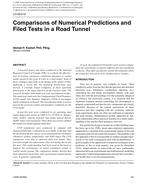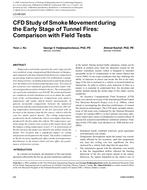-
-
Available Formats
- Options
- Availability
- Priced From ( in USD )
-
Available Formats
-
- Immediate download
-
$16.00Members pay $7.00
- Add to Cart
Customers Who Bought This Also Bought
-

OR-10-001 -- The Design of Natural Ventilation Systems to...
Priced From $16.00 -

LO-09-030 -- In-Situ Performance of Stratified Air Distri...
Priced From $16.00 -

LO-09-019 -- Comparisons of Numerical Predictions and Fil...
Priced From $16.00 -

LO-09-001 -- Determining Off-Normal Solar Optical Propert...
Priced From $16.00
About This Item
Full Description
Temperature and smoke spread in the early stage of a fire were modeled, using computational fluid dynamic techniques, and compared with data obtained from field tests conducted in an operating roadway tunnel in the City of Montreal, Canada. Fire characteristics, including temperatures and smoke spread over the tunnel were measured during these tests. Two types of fire scenarios were simulated: gasoline pool fires under vehicles and gasoline pool fires behind vehicles. The estimated fire size used in the simulations was 650 kW. The initial and boundary conditions of each simulation were set to mimic the conditions of the corresponding test. Comparisons were made to temperature and smoke optical density measurements. In general, favourable comparisons between the numerical predictions and the experimental data were observed. The ceiling temperature downstream of the fire decreased with an increase in the distance from the fire source, which is also the case for smoke optical density. The ceiling temperatures produced by the fire behind the vehicle were higher than those produced by the fire under the vehicle. The temperature variation along the central cross section of the tunnel shows that the highest ceiling temperature occurs 3~5 m downstream of the fire because the plume was tilted by the airflow inside the tunnel. Fire location had a significant impact on ceiling temperature development in the tunnel. The airflow conditions at the fire location significantly affect smoke and temperature distributions in the tunnel which will also affect the performance of detection systems.
Units: SI





